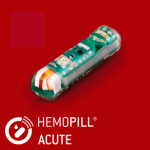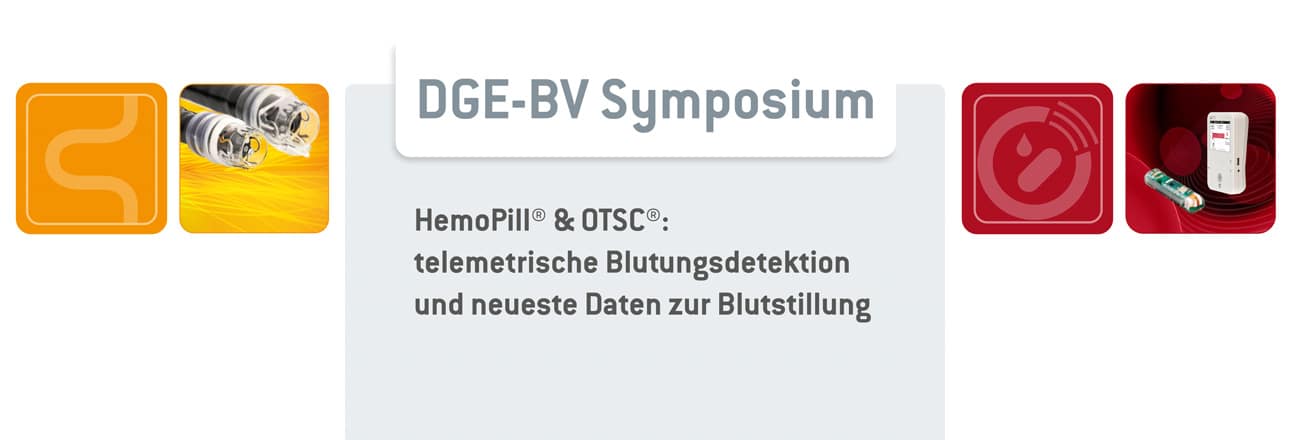The 50th Conference of the German Society for Endoscopy and Imaging Procedures (DGE-BV) took place on April 8 – 10, 2021. Subject of the Symposium on April 8th was telemetric haemorrhage detection with the HemoPill® acute followed by two presentations on hemostasis with the OTSC® System. Here you can find the summary of the presentation by Dr. T. Brunk, the presentation by Prof. Schmidt and Prof. Caca will follow in the next weeks. To rewatch the symposium (in German only) please click here: https://ovesco.com/de/dge-bv-symposium-2021/
HemoPill® acute is a suitable tool for risk stratification in upper GI bleeding in questions of emergency esophagogastroduodenoscopy (EGD) and inpatient admission
Dr. Thomas Brunk, Berlin: The HemoPill® acute reliably detects and excludes intraluminal blood/hematine
T. Brunk, Vivantes Hospital Friedrichshain, Berlin, presented a retrospective observational study on HemoPill application in cases of suspected upper GI bleeding and a case series with HemoPill application and following double-balloon enteroscopy in cases of suspected small intestine bleeding.
The HemoPill acute is a capsule with novel sensor technique for telemetric diagnosis of blood/hematine. An essential and unique advantage of the HemoPill is the possibility of application in patients without empty stomach. Measurements with the HemoPill allow a reliable discrimination between blood/hematine and other fluids.
Between 06/2019 and 03/2020, a retrospective observational study with the HemoPill was performed. 61 cases of HemoPill application in 12 centers in Germany and Switzerland were evaluated. Indications for HemoPill application were suspected upper GI bleeding, small intestine bleeding, or recurrent GI bleeding. Primary endpoints of the study were correct detection and correct exclusion of haemorrhage, respectively, and technical success of the measurement. Secondary endpoints were complications and impacts on the further clinical course.
60 measurements could be included in the evaluation, one measurement was technically not utilisable, the technical success rate was 98 %. 35/60 measurements were positive, in 20 of these patients a source of bleeding was detected endoscopically, in 9 patients no source of bleeding was found by gastroscopy, in 6 patients no endoscopy was performed. The mean latency between HemoPill examination and endoscopic examination was 15h15min in the 9 patients without endoscopic findings of a bleeding source, which could also be a reason for the lack of detectability. In 25/60 cases the HemoPill measurement gave a negative test result, in 20 of these patients no bleeding source was found in the gastroscopy, in the 5 other patients of this group no endoscopy was performed, in none of these patients clinical signs of bleeding occurred until discharge. In summary, both, blood detection and haemorrhage exclusion corresponded to the results of endoscopy and the further clinical symptoms. Apart from one case with temporary mild swallowing symptoms no complications occurred.
The results of HemoPill measurements had an impact on the further clinical course. A positive result led to a significant reduction of the latency to EGD (3h8min vs. 19h52min). A negative result led to a change in indi-cation for EGD from urgent to elective in 10/25 cases, and to avoidance of control EGD in one case.
The authors concluded that the HemoPill reliably detects and excludes upper GI bleeding. The application is comfortable and low in risk, the interpretation of the measurement is simple. Therefore, the HemoPill seems to be a suitable tool for risk stratification in upper GI bleeding. This interesting approach is currently subject of a prospective trial at the Universitiy Clinic Wuerzburg.
Afterwards, T. Brunk presented a case series of 13 patients with melena and negative EGD who underwent HemoPill application. In 7/13 cases, blood was detected by the HemoPill and a double-balloon-enteroscopy was performed subsequently within 24h. In all 7 cases angiodysplasias were found and obliterated. In 3 of these 7 cases the lesion was still actively bleeding.
In conclusion also active bleeding in the small intestine can be reliably detected by HemoPill application. For this, no preparation of the small intestine is necessary. The interpretation of the measurement results is fast and simple. A clear indication for HemoPill application in patients with melena and negative EGD should be the subject of further research.
HemoPill® acute: telemetric diagnosis of GI haemorrhage with novel sensor technique
(HemoPill® acute: telemetrische Diagnostik von GI-Blutungen mit neuartiger Sensortechnik)
T.Brunk, Vivantes Klinikum Friedrichhain, Berlin
Symposium presentation at the virtuell DGE-BV congress 2021
 |
 |


 Deutsch
Deutsch  Français
Français 